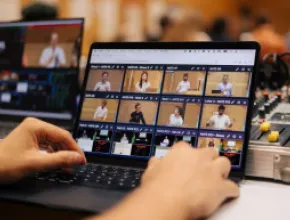Anyone who’s been to a major meetings industry event in the past couple of years has to have noticed the creeping influence of the virtual world, from live Twitter feeds for everyone to see and onsite bloggers all the way to virtual events that run concurrently with a face-to-face component.
Augmenting a live meeting, convention or event with a virtual version provides a variety of benefits and, perhaps contrary to intuition, does not cannibalize attendance. Rather, according to those who work the field, it can actually be an attendance driver for a subsequent event by demonstrating the quality of the content that is delivered.
“It’s a great way for people to experience the event and then decide to participate in person,” says Michael Doyle, executive director of the Virtual Edge Institute (www.virtualedgeinstitute.com), which primarily works with smaller organizations and associations but also co-locates its annual Virtual Edge Summit with PCMA’s Annual Meeting. “The first question is usually, ‘Why should I do this, and will it cannibalize my physical event?’ What we’ve found across many organizations that have tracked it is that their attendance at their physical event continues to go up as they go online.
“So it’s a great way to market your event for someone who hasn’t been there before,” he continues. “And there’s always people who can’t attend the event, so this is a good way for them to keep track of what’s going on at the event. So what happens is that they realize they missed a great event and they put it on their calendar for next year.”
According to Keith Huegel, a virtual products manager at meetings industry giant Freeman (www.freemanco.com), which partners with HSMAI to provide MEET On (www.hsmaimeet.com), the virtual component for its MEET events, approximately one in four virtual attendees go to the on-site event the following year.
To Huegel, providing a virtual component is the obvious way to attract new members to an organization, especially associations.
“Think outreach,” he says. “If you’re looking to draw in new members you need to have an online component. That’s the only way you’re going to reach those individuals.”
According to Huegel, there are a few key areas that event organizers should concentrate on:
- Content: It needs to be something that’s appetizing as a driver to the event—focus on supplying a small portion of that content. Don’t give away too much, but enough to drive them to attend the live meeting the following year.
- Marketing: Just like any event, you need to do sufficient marketing—social media, periodicals, website, e-mail marketing…You need to bring eyes to the platform and then get those eyes into the platform.
- Presentation: If you’re going to do a virtual event you need to think about how you want that content to be presented; live interaction, just on-demand content or SimuLive (a Freeman product that combines on-demand content with live interaction).
- Bandwidth On-Site: Make sure you have adequate bandwidth and dedicated Internet bandwidth that’s going to be able to handle your needs for streaming content out of the facility. A little dropped streaming packet will knock your stream off and you’ll have to back and restart. The more-sophisticated technology providers out there have systems to track what switch or router is acting up, so they can make sure the Internet provider fixes it.
- Viewer Bandwidth: Think about where the audience is watching from. If you’re going to do live streaming, and your audience is watching from their office, they’ll need to be able to stream 600 kilobytes per second, generally, for viewing a live stream. The potential in-office bandwidth problem can also be exacerbated by people using multiple wireless devices, as modern consumers are wont to do. You can bring down a network very quickly when multiple people are using wireless devices at the same time.
According the Doyle, event organizers should have a clear perspective on the purpose and business model is for the event before proceeding down the digital path.
“I think that the main thing is to really figure out what the business drivers are for the event, because that’s going to allow you to deal with every other decision about the event, whether it’s marketing, measurement, content, what the engagement strategy is…everything kind of comes from those primary drivers,” Doyle says. “After you get that strategy down, and you know what you want attendees to get out of the experience, that’ when you can really look at the technologies that are available to help you deliver on that.”
Doyle says the key drivers to be aware of are content, engagement, technology, marketing, execution and measurement.
“Most every aspect of your virtual engagement is going to depend on certain factors that are unique to your situation, he says. “ The basic one is ‘why are you doing this in the first place?’ Some people are doing it to try to make money, some to marketing something, others because they’re trying to serve their organization.
“It depends on what your objectives are, and then that really drives what your content strategy is going to be,” he adds. “In some cases, if you are in an industry where there are required certifications or CEUs [continuing education units], that’s a different situation than for an industry that doesn’t.
From the standpoint of using the virtual event as a platform to market subsequent face events, Doyle says many organizations focus on streaming networking events, and then augment that with interviews with attendees who can attest to the value of being there face-to-face. This can also be tied together with content from keynotes to up the promotional ante.
Virtual events can also be monetized by getting sponsorships for particular sessions or tracks of sessions—or all of the educational content. Doyle says organizations can also stream sponsor videos before sessions start, or have the sponsor moderate or introduce the session.






